The team
So that the children can make their discoveries in complete confidence, 2 referent educators trained in Montessori pedagogy accompany them (one English-speaking and one French-speaking). The educators work in close collaboration with the parents, who play an essential role in the full development of their child.
In this environment, the children are free to move around and to choose their activity, while being led to progressively integrate the principle of mutual respect.
This first experience in a small society is an important moment that lays the foundations for a sense of security and self-esteem.
The Trotters are welcomed in a small group of 14 to 19 children, in a Montessori environment that specifically meets their needs. It is adapted to the age, size and strength of the children.
This environment favours the children’s learning of independence, the sensitive period of order, the development of language and motor skills.




Bilingualism in daily life
The Montessori l’Idylle school is bilingual in French and English : the teams address the children only in their own languages.
The children learn a language effortlessly since, from birth to 6 years old, they are in a period of intensive language acquisition and thus absorb a second language very easily as long as it is part of their daily environment.
Both languages are an integral part of the children’s daily experience.
Adaptations for children from 18 months
Integration begins at the end of August, in accordance with the canton’s school calendar. Children can join the class during the year, from 18 months of age.
An adaptation schedule is proposed to each child to enable them to discover the new environment in a progressive manner.
Typical day
Les Trotteurs’ class offers bilingual teaching with one English-speaking and one French-speaking educator in the classroom.
We welcome between 14 and 19 children in the morning and a maximum of 10 children for lunch and afternoons. They are thus present either in the morning only (8am – 12 noon) or during the whole day (8am – 3pm).
We offer an end of day welcome between 3pm and 6pm which can be regular or punctual according to the needs of each child.
Morning
Upon arrival, the children can choose an activity of their choice and continue their activities until about 10.30 am. The educators take care of the children’s well-being and accompany them in discovering the equipment.
From 10.30 am, a snack is offered to the whole group. Fruit is also available to the children throughout the morning.
Changes are made just before leaving the classroom for the daily outing at around 11am.
We either go to visit the animals on the local farms or we go up near the church to enjoy the view of Lake Geneva.
Lunch and afternoon
The children who are only left in the morning leave school at 11.45 am.
The remaining group gets ready for lunch. Each child helps themselves one after the other and they are invited to taste each food offered.
Each child clears his or her table and continues to prepare for the nap by brushing teeth and using the toilet. Thus, the nap starts at 1pm. The next departures are from 2.45pm – 3pm.
The end of day reception is then offered until 6pm. The children enjoy various activities during this time spent together with the 3-6 year olds who join them from 3pm !
The Trotters’ teaching material
Maria Montessori favoured few and chosen materials. A copy of each material allows one to live the social experience of waiting one’s turn to be able to use it and to be aware of the notion of patience in a child under 3 years of age. It was on the basis of her observations, of what the children showed her to see, that Maria Montessori thought up and developed the material.
This material has proved its worth, and today it is identical in all Montessori classes.
All the proposed activities have a defined goal. It is through the structured activity that the child’s thinking and concentration will be able to develop. Montessori activities encourage manipulation and repetition. Concentration comes from these repetitions. The child then discovers inner peace.
The 4 areas present in the atmosphere
The materials are classified in 4 areas:
practical life activities, manipulation, language, expression (art).
From the age of 2 years, children are increasingly attracted by practical life activities, personal care, and the care of the indoor and outdoor environment.
The child feels an inner motivation which pushes him to imitate the actions of adults, such as the tasks we do daily (washing dishes, clothes or shining shoes for example). Imitation is a strong need of the child during his first years.
Many practical life exercises involve the use of water, which most children naturally enjoy playing with. Carrying water in a container and pouring it into a basin helps the child to perfect his coordination. As he begins to be absorbed by an activity, such as cleaning a table, he gradually increases his concentration time.


Thanks to the numerous manipulations of objects, the child develops little by little his ability to concentrate, his fine motor skills, his grasp, his eye/hand coordination.
The proposed activities encourage the development of eye-hand coordination: pouring, sorting, screwing but also other activities of practical life such as cleaning a mirror or taking care of a plant.
These exercises help the child to pay attention, to have precise gestures, to control his strength, to observe and to be patient. Indirectly, all of these exercises, which promote the development of hand-eye coordination, prepare the hand for writing.
Before the age of 6, the child absorbs language unconsciously. The team takes care to speak very precisely with the children.
Around the age of 2, there is a real explosion of language. Throughout this period, the young child will learn to communicate in his or her mother tongue and in a totally autonomous way.
The enrichment and development of the children’s vocabulary is encouraged by several supports, notably classified pictures. This tool is interesting to help the child classify and relate objects and their environment, but also to help them discover other elements that they do not encounter, or less so, such as the animals of the savannah for example.
All language activities allowing the development of vocabulary in English and French, not forgetting the many stories read and nursery rhymes sung!


The children have materials at their disposal and can thus express their creativity through different art techniques which they can discover in the classroom.
Children can discover watercolour, gouache, as well as the print left by stamps or greasy chalk for example. The children cut out, glue and multiply their experiments to perfect their creations as they rehearse. The development of fine motor skills is also enhanced by the introduction to the arts.
Children discover various musical instruments that they can play freely! Together, they dance to a variety of different music.
